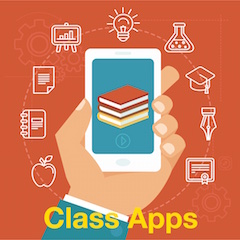Tools to Help Students Base Opinions in Fact
A MiddleWeb Blog
 As a teenager growing up in Texas in the early 90’s, I found everything seemed much more straightforward. My brother and I mowed the lawn without a fuss because our parents told us to. The coolest car was a Mustang 5.0, and we always rooted for Emmitt Smith and the Dallas Cowboys.
As a teenager growing up in Texas in the early 90’s, I found everything seemed much more straightforward. My brother and I mowed the lawn without a fuss because our parents told us to. The coolest car was a Mustang 5.0, and we always rooted for Emmitt Smith and the Dallas Cowboys.
It was only later that I realized that my attitudes, actions, and words were merely the amalgam of where I lived, who/what I surrounded myself with, and what was said by those whom I most trusted.
Over time, as I emerged from adolescence, these underlying influences shifted, and so did my opinions and perspective. The details have changed dramatically for teens since those days, but some fundamentals remain much the same.
What Our Kids (Really) Care About

Listen more carefully, however, and you will discover that they care deeply about a number of complex issues that include the environment, social justice, and even politics.
However, the challenges lie in helping adolescents move beyond simply regurgitating the views they absorb from incidental browsing, or their favorite YouTubers, or polarized social media feeds.
A teacher’s job isn’t to try to change WHAT students think, but rather to transform HOW they think. One way to do this is by designing activities that model and scaffold the process of making evidence-based claims only after locating, contemplating, and critically examining data.
Tapping into the Affect
Kids – and all of us for that matter – work harder when invested in a cause or topic that we care deeply about. In a past post, I explored in detail how students’ feelings towards topics and tasks tend to work either as a catalyst or deterrent to learning.
As educators we must recognize that effective teaching will only happen if we cultivate our students’ affective investment in the lesson. Interest and investiture in a topic help students to process new information, engage in difficult tasks, and develop a deeper understanding of learning experiences.
Educators should start by identifying issues, topics, and problems that adolescents are likely to take an interest in. I suggest beginning the process by brainstorming answers to the following question: What topics, problems or issues are my students likely to care about?
I like to try to answer these questions myself based on my interactions with students before, during, and after class as well as what I overhear during less structured time during passing periods, at lunch time, and before/after school.
Next I ask my colleagues to help me brainstorm for more ideas. Then I ask my students to contribute their own topics, problems or issues to the list. I narrow the list down to a handful of topics that seem to appear most frequently.
Creating and Analyzing Data with Your Students
The next step is to ask yourself: What kind of data can I get my hands on that will get my kiddos thinking about the topics, problems or issues identified above?
One solution is to use a free, easy-to-use surveying tool to gather information from students about their views and perspectives. Of all the survey tools out there such as Type Form, Survey Monkey, and Poll Everywhere, my favorite continues to be Google Forms. It allows users to create an unlimited number of surveys for an unlimited number of students. It also exports data in spreadsheet form and/or in graphic form.
Teachers can use Google Forms to quickly create a survey about an issue their students are likely to care about, then quickly display/share the results. My tutorial for doing this can be found here:
Teachers then ask each student to work individually to examine the tabulated results and answer questions such as…
► What patterns or trends do you notice?
► When you look at the data, what catches your attention or surprises you?
► In what ways are your responses similar to that of the rest of the class?
► In what ways are your responses dissimilar to that of the rest of the class?
Students then visit with a partner/small group to discuss their responses. Next, in whole class discussion, students share their observations as the teacher asks questions designed to guide them through the process of using data to explain their conclusions. Consider questions like….
► What in the data/results brought you to that conclusion?
► What makes you say that?
► What do you mean? Can you help me understand better?
► So, what evidence would you use to explain…?
► How do you know?
This allows the teacher to model the process of converting raw information into analyzed data and helps students formulate an opinion based on evidence, rather than relying solely on their own opinion and responses.
Real World Data
Another option is for teachers to find and format real-life data sets for students to analyze. Trust me. It really is easier than it sounds.
Teachers can start by thinking about the topics/issues that students are likely to find interesting, then go on a hunt using existing data sets made open to the public and/or designed for classroom activities. Some of my favorite data sets include:
The York Times collection of infographics
You could also just search online for something like the Spotify Music Hits of 2020 data set to find some numbers to pique your students’ interests. Locate and download the CSV file, then import it into Google sheets for your students to use. Be sure to do some cleaning up to ensure the data is useful but not overwhelming to your students. My tutorial for doing so can be found here:
Like an example? Here’s an interesting data set I’ve used: Pixar vs DreamWorks.
Overview and possible guiding questions based on the data:
Animated films are a multi-billion dollar industry. The two biggest producers of animated films are DreamWorks and Pixar. The two have been going head to head for more than ten years now. So how do they stack up to each other?
1. Which company is making more money on their films?
2. According to critics, which company makes the better films?
3. What other ways could you compare the two companies?
Productive conflict is created as students have to come up with and defend informed opinions about which animated movie company, DreamWorks or Pixar, has been more successful.
Facts vs. Fugazzi
Like all of us, middle schoolers are struggling to make sense of a deluge of information. Is this real or fake news? If it is real news, can I trust it? How can I ensure that my views are informed by facts and not fugazzi?
I don’t want students who are afraid of having or expressing an opinion. What I really desire for them is the ability to think first and judge second – to think critically and examine varied perspectives, data, and other evidence before choosing and defending a position.
Feature credit: Pixar Vs Dreamworks, Dana Middle School News.
References
Peng, C. T., Wu, T. Y., Chen, Y., & Atkin, D. J. (2019). Comparing and modeling via social media: The social influences of fitspiration on male instagram users’ work out intention. Computers in Human Behavior, 99, 156-167.
Valdez, A. C., Burbach, L., & Ziefle, M. (2018, July). Political opinions of us and them and the influence of digital media usage. In International Conference on Social Computing and Social Media (pp. 189-202). Springer, Cham.
Westenberg, W. M. (2016). The influence of YouTubers on teenagers: a descriptive research about the role YouTubers play in the life of their teenage viewers (Master’s thesis, University of Twente).































Thanks for this post! It’s quite important to keep up with the times and try to understand the interests of your tudents.